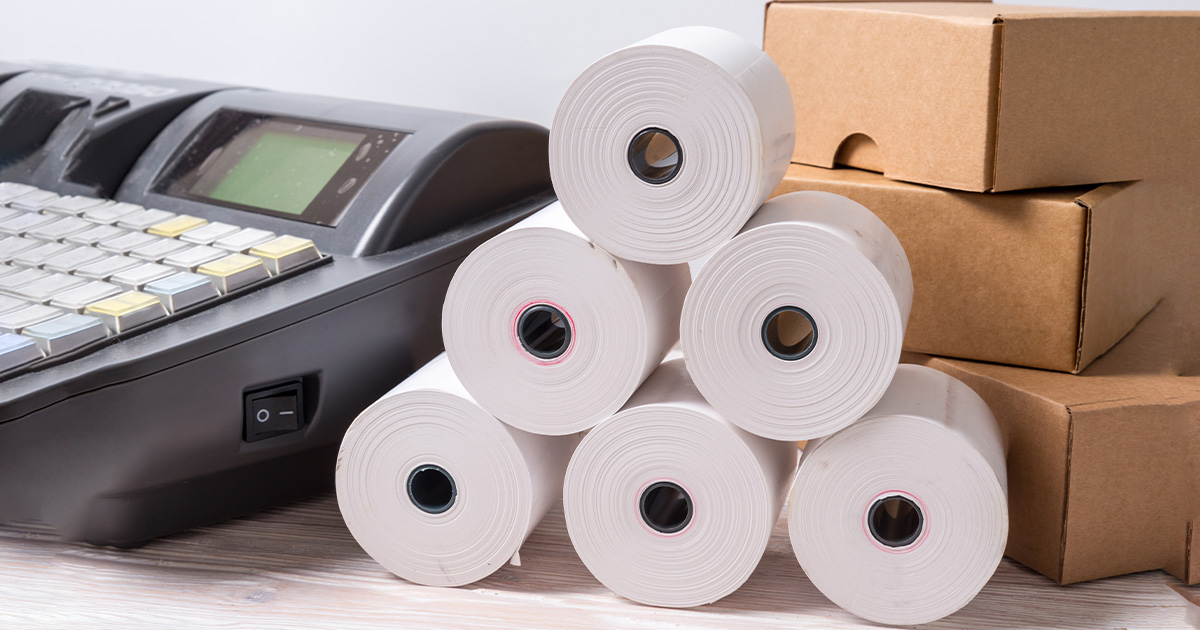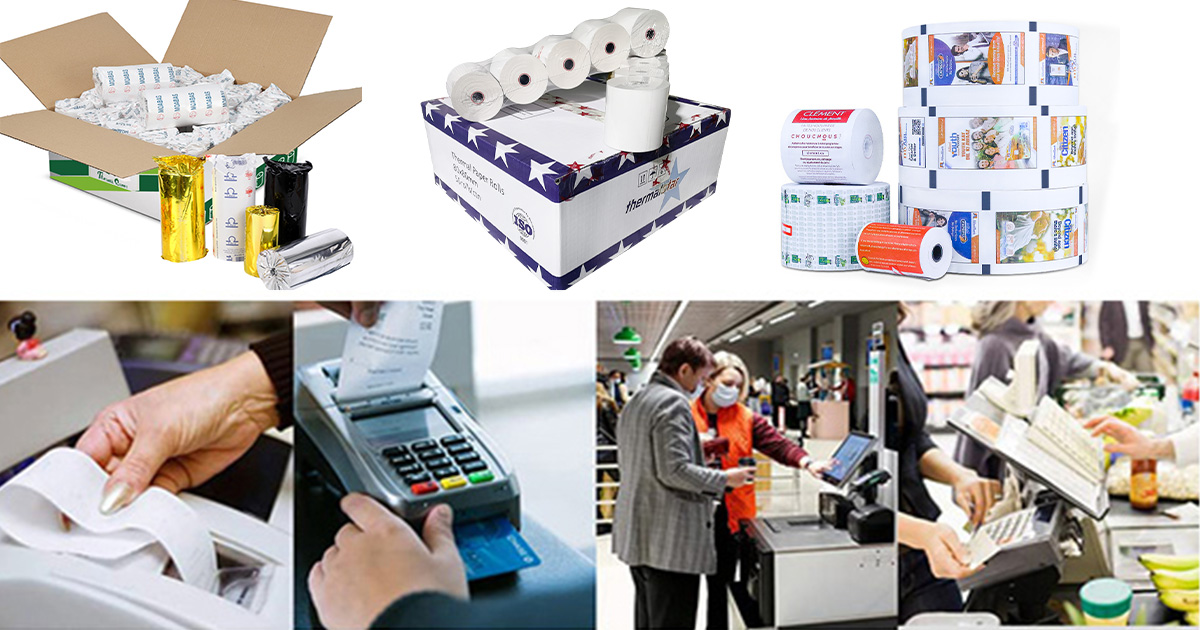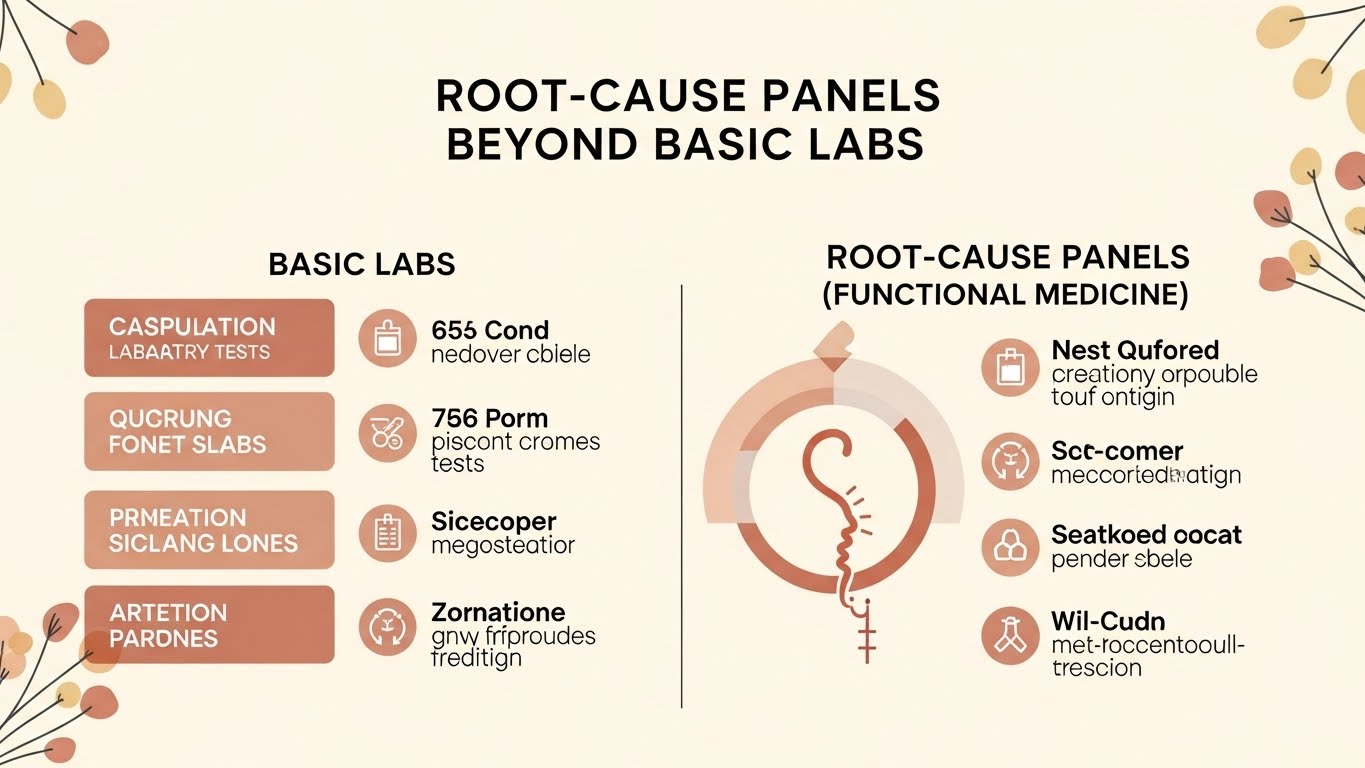GENERAL
How Long is A 1 Roll of Thermal Paper?

The performance of your printer depends on selecting the appropriate thermal paper roll size. Finding suitable paper rolls, printer ribbons, and cleaning supplies online is simple if you know the type of your receipt printer. This advice, however, will assist you in measuring and determining the appropriate thermal paper roll size if you do not have the printer model information on hand.
Thermal paper has many uses, and depending on the use case, printers can have specifications. Customers must select the appropriate thermal paper specs. You achieve knowledge on how to choose the proper tube core length, paper roll length, paper roll breadth, and paper roll diameter for your application. If you need thermal paper rolls, you should buy thermal paper rolls wholesale at a reasonable price.
Thermal paper rolls
The first step in choosing and using paper rolls in your printer is to pick the proper size for thermal paper rolls. You can typically find out what products (paper rolls, printer ribbons, cleaning supplies, etc.) are compatible with your receipt printer by searching for the model name on Google. If you are a seasoned consumer of thermal paper, you are aware that rolls of the same size come in varying lengths for different paper grades. An 80 x 80 mm paper roll is our most popular paper size. You must regularly replace the paper roll in your printer since thicker materials require less paper per roll, which limits the number of receipts.
Paper roll width
The first and most important measurement in the paper roll’s specs is its width. This dimension establishes whether the paper will properly fit into your printer. Measured from one edge to the other, the breadth covers the whole surface of the roll. On a receipt, it is crucial to measure the whole width of the paper, from edge to edge, rather than simply the width of the written text. Measure in millimeters for precision since even little variations may have a big impact.
The standard unit of measurement for thermal paper roll widths in the US is inches. Two and three quarter inches are common widths. The two most common paper roll sizes in other nations are 57mm and 80mm. Thermal receipt printers typically utilize an 80mm width roll, although most credit card terminals and portable printers use 57mm wide rolls.
The first parameter to examine is the paper roll’s width, and the measurement needs to be precise to the nearest millimeter. If there is even a one-millimeter measuring discrepancy, the paper roll might not fit into the printer. The most widely used sizes available are 80mm and 57mm, and equipment can also be used for 76mm, 110mm, and other unique sizes. Certain nations that use feet as a unit of measurement will buy 3 1/8 and 2 1/4 feet.

Length of Paper Roll
The amount of paper wound onto the roll is measured by the roll length. While it’s not a crucial measurement to know when ordering paper rolls, a longer roll will inevitably last longer and require fewer replacements. For instance, the length of an 80 × 80 mm thermal paper roll might range from 50 to 90 meters. You can buy these thermal paper rolls wholesaleto meet your requirements. See our helpful post on how to measure the length of a paper roll for more information. Thermal paper is usually available in the following lengths: 50, 80, 185, 220, 230, and 273 feet.
Paper roll diameter
Measuring the distance between the center and both ends through the paper roll’s core, the diameter of the roll is the second criterion to verify. The amount must be one millimeter smaller than the paper roll that the present printer uses. The paper roll’s diameter varies from 25 to 300 mm, and its dimensions are altered to suit the printer. The paper will be longer and survive longer if the paper roll has a greater diameter.
Tube core length
The inner diameter and outer diameter are the two halves of the tube core length. The paper rolls into the printer to function if the inner diameter of the tube core is tiny. Paper, plastic, and honeycomb tubes are the materials for tube cores that are found in the market. Sizes like 13×19 paper tubes, 40×44 paper tubes, 13×17 plastic tubes, 12×22 honeycomb tubes, etc., are utilized. Know that there will be fewer meters of paper rolls with the same diameter the higher the outer diameter of the tube core. Paper rolls without tubes are also an excellent choice for clients who need extra paper.
Core Size
Rolling the paper onto a tube has a diameter, which is its core size. For cores, there are two crucial measurements:
Core ID. (Inside Diameter): The size of the hole in the middle of the core is known as its core ID (inside diameter). It is crucial because the core ID has to fit the pins or spindles that certain machines employ to retain the roll. The typical core diameter is 12.7 mm, or 7/16″.
Core OD. (Outside Diameter): These are the core’s overall dimensions, with the hole included. Although it has less of an impact than the core ID, it still has an impact on the roll’s length and diameter.
The Relevance of Accurate Measurements
For a number of reasons, it is crucial to measure your thermal paper rolls correctly.
- Compatibility: Using the incorrect size paper roll may result in printer jams or damage. Having the right measurements will facilitate the printer’s smooth operation.
- Efficiency: By lowering the frequency of roll changes, particularly during peak hours, the proper roll size may increase efficiency.
- Cost-effectiveness: Acquiring the appropriate size paper roll guarantees optimal value for your money and helps avoid waste. Incorrect sizing might mean having to deal with regular replacements or needing to buy extra supplies.
Common Sizes and Their Uses
Different applications call for different sizes of thermal printers. You can pick the ideal paper roll for your requirements by being aware of the typical sizes and their applications:
- 80mm x 80mm Rolls: Rolls measuring 80 mm by 80 mm are the most often used sizes in retail stores, restaurants, and point-of-sale (POS) systems. They ensure fewer replacements during busy times by offering an excellent balance between width and roll length.
- 57mm x 30mm Rolls: Handheld or portable printers usually utilize these smaller rolls. For mobile applications like delivery services or small-scale retail businesses, they are perfect.
- 110mm x 55mm Rolls: Rolls measuring 110 mm by 55 mm are used in bigger receipt printers, which are often seen in department shops and supermarkets. More intricate printing, such as those with logos and advertising messaging, are possible due to the bigger width.
Types of Thermal Paper Rolls
In addition to sizes, thermal paper rolls are available in several varieties, each of which is appropriate for a particular use. These are a few typical kinds:
The most popular kind of thermal paper for regular transactions is the standard version. It is affordable and offers crisp invoice and receipt printing.
- Top-Coated Thermal Paper: This kind of paper contains an extra layer of coating that provides defense against moisture, oil, and scuffs. It is perfect for situations where printed materials must last longer or when there are rough handling or environmental factors that affect the paper.
- Synthetic Thermal Paper: This sturdy paper kind is impervious to tearing, water, and grease. It is often used for tickets, badges, and labels that must survive challenging conditions.
- Linerless Thermal Paper: Thermal paper rolls without a backing liner are known as linerless rolls. This is in contrast to conventional thermal paper rolls. Their use is common in labeling applications where waste reduction is a top priority.
Considerations for Selecting Thermal Paper Rolls
There are a few things to take into account when choosing thermal paper rolls to make sure your printer operates at its peak efficiency:
- Printer Interoperability: Always refer to the printer’s specs or the handbook to determine the ideal sizes and kinds of paper rolls. Using rollers that are compatible will guarantee optimum performance and avoid jams.
- Print Quality: Take into account the required print quality. For intricate images or logos, use premium thermal paper with greater sensitivity and a top coat if you need high-quality prints.
- Durability: Consider how long you want the printed material to remain valid. To ensure longer-lasting receipts, choose top-coated or synthetic thermal paper for increased durability.
- Environmental Conditions: Take into account the circumstances around the usage of the paper. Choose a sort of paper that gives resistance to factors like moisture, grease, and severe temperatures if they will be present in it.
- Cost: Although it may be tempting to choose the least expensive choice, weigh the benefits in total. Although high-quality paper may initially cost more, it may save you money over time by lowering printer maintenance costs and offering improved functionality.
In summary
For your thermal printer to operate well and last a long time, the size and kind of thermal paper roll you choose is essential. You can guarantee compatibility and efficiency by being aware of the important metrics and variables to take into account. Maintaining the quality of your thermal paper rolls via proper storage can guarantee crisp, long-lasting printouts. Choosing the appropriate thermal paper rolls for your thermal printer can help you achieve the finest prints possible on receipts, labels, and tickets.
GENERAL
Functional Medicine Laboratory Test Explained: Root-Cause Panels Beyond Basic Labs

Persistent fatigue, digestive discomfort, or simply not feeling well: these conditions remain undiagnosed and unknowingly become a part of life. The result is a hindrance in reaching your full potential as the body is busy coping with the issues.
The key to solving the problem is right identification. Where conventional lab reports come out to be normal, it is the functional medicine lab tests that help uncover the root cause of unexplained feelings of not being well. Does the term ‘functional medicine’ sound new to you? Or have you heard it but are unsure what it actually means? We explain the details here while relating how it upgrades the quality of life. Scroll down to know.
What is Functional Medicine?
Functional medicine is a root cause based approach to healthcare. Instead of only treating symptoms, it focuses on why a health issue is happening. It achieves this by understanding how different systems of the body, such as the gut, hormones, immune system, metabolism and genetics, are connected with each other.
The functional medicine focuses on:
- Impact of the diet, lifestyle, stress, environment and genetics on health
- Individual differences rather than one-size-fits-all treatment
- Long-term healing instead of temporary symptom suppression
Understand this with an example: If a patient faces acid reflux or bloating, the common approach is to treat with antacids. Functional medicine identifies whether the issue is coming from gut infections, poor digestion, inflammation or food sensitivities.
What Are Functional Medicine Laboratory Tests?
Functional medicine laboratory tests are advanced diagnostic tests. They help identify early imbalances and hidden dysfunctions before they turn into disease. Generally, these tests assess:
- Hormonal balance: To identify hormonal imbalances and manage the symptoms concerning heavy and painful periods, infertility, weight gain, migraines and more.
- Gut health: To identify abundance and diversity of harmful and beneficial microbes, including bacteria, viruses, parasites, fungi and others. It helps deal with chronic conditions, skin issues, inflammation, autoimmune disorders and more.
- Genetic tendencies: To recognise the body’s capability to process and metabolise fat and carbohydrate, risk of chronic diseases, optimise power, endurance and recovery, and more. It helps achieve peak fitness, manage weight, improve mental health and more.
- Immune response: To know about compounds (such as food) sensitive to the body and to learn about gut permeability.
- Nutritional profile: To identify the deficiencies of antioxidants, minerals, B-vitamins, digestive support, fatty acids, amino acids, and omega-3, 6, and 9 in the body.
Importance of Functional Medicine Laboratory Tests
The functional medicine approach plays an important role in achieving well-being for the individual. Here is how the approach works beyond the basic lab tests to help patients feel good:
Helps Uncover Root Causes of Chronic Symptoms
Functional medicine lab tests are useful for people dealing with chronic medical conditions such as chronic fatigue, digestive problems, autoimmune conditions or unexplained symptoms. These tests provide insight into more detailed aspects of the body at the foundational level. Interpreting them offers enough information to handle the mentioned problems.
Detects Issues Missed by Conventional Testing
The functional medicine lab tests reveal underlying imbalances such as nutrient deficiencies, hormonal dysfunctions, hidden infections, or inflammation related triggers. Many of these imbalances may not appear in standard lab ranges. Using these insights helps reduce symptoms and improve body functionality, thus offering relief.
Enable Early Detection and Prevention
The functional medicine lab tests allow timely identification of gut dysbiosis, allergic foods, antioxidant or fatty acid deficiencies, bacterial and fungal toxins, and much more. It involves testing in the scenario of discomfort before the problems progress into more serious conditions. The timely interventions, like lifestyle, dietary, or nutritional adjustments, support long-term health.
Guides Personalised and Targeted Interventions
Test results are interpreted by practitioners in combination with various individual aspects, including but not limited to existing lifestyle, previous medical history, previous drug responses, symptoms, and other details. Subsequently, the professionals develop a tailored plan based on individual needs to provide relevant and measurable interventions.
Tracks Progress and Treatment Effectiveness
Further insights through follow-ups about the personalised plans ensure the effectiveness of the suggested modifications. Depending on the progress and results, the adjustments can be made. Hence, it supports a proactive and evidence-based approach to health management.
Comparison Between Standard Laboratory Tests and Functional Medicine Laboratory Tests
The differences between standard or conventional laboratory tests and functional medicine laboratory tests are as follows:
| Parameter | Conventional Laboratory Tests | Functional Medicine Laboratory Tests |
| Primary focus | Diagnosis of existing disease and acute conditions | Optimising functional well-being and early imbalance detection |
| Approach to health | Reactive, i.e., it involves taking action once disease markers appear | Proactive, i.e., identification of the early signs of dysfunction before disease develops |
| Personalisation | Limited personal context | Interpreted as per the individual biochemistry, lifestyle, and health goals |
| Examples of tests | Complete Blood count (CBC), lipid panel, basic thyroid tests, and others | Gut health tests, hormone panels, nutrient status, and more |
| Outcome | Confirms presence or absence of disease | Guides targeted interventions to maintain and improve health |
Conclusion
Functional medicine laboratory tests offer comprehensive and deeper insights into the body’s functionality. They allow early diagnosis and personalised intervention to offer relief from discomforts that are challenging to understand with conventional tests. The functional medicine focuses on gut health, nutrition, hormones, immune response, and genetic tendencies, among others, to identify the root causes. Also, it works on a proactive approach, helping the individual feel better and confident.
GENERAL
Quick Enrollment Steps for Your Next MyCPR NOW Course

When it comes to getting certified in CPR, First Aid, or BLS, MyCPR NOW makes the process quick, easy, and accessible. Whether you’re a student, caregiver, or healthcare worker, enrolling in a certification course has never been simpler. Below, we’ll walk you through the quick and easy steps you need to take to get started with your next MyCPR NOW course.
Step 1: Visit the MyCPR NOW Website
The first step to enrolling in a MyCPR NOW course is to visit the official website: MyCPR NOW. On the homepage, you’ll find a clean and user-friendly interface that will guide you to the courses you need.
Whether you’re looking for CPR certification, First Aid, or more advanced courses like BLS (Basic Life Support), everything is clearly listed, so you can easily find the course that suits your needs.
Step 2: Choose the Right Course for You
Once you’re on the site, you’ll need to browse through the available courses and select the one that best fits your needs. MyCPR NOW offers several certifications, including:
- CPR
- First Aid
- CPR + First Aid
- CPR + First Aid + Bloodborne Pathogens (BBP)
- BLS
- Pet CPR + First Aid
Depending on your profession or personal requirements, you can choose a single certification or a combination. For example, if you’re a healthcare professional, you might need BLS certification, while a teacher or caregiver may only need CPR + First Aid.
Step 3: Create an Account (Optional)
Creating an account is optional, but it offers several benefits. By registering, you can track your progress, access your courses easily, and receive your certification upon completion.
To create an account:
- Click on the “Sign Up” or “Create Account” button.
- Enter your basic details, including your name, email, and preferred password.
- You can also register via social media accounts for even quicker access.
Once your account is created, you’ll have access to your dashboard, where you can start your course and track your progress as you move through the material.
Step 4: Make Your Payment
After selecting your course, you’ll be directed to the payment page. MyCPR NOW offers flexible payment options, including credit/debit cards and other secure payment methods.
The cost of each course varies depending on the certification you choose, but there are often discounts or bundles available if you’re enrolling in multiple courses. Rest assured, the payment process is fast and secure, ensuring your personal information is protected.
Step 5: Start Your Course
Once your payment is complete, you can immediately begin your course. You’ll gain 24/7 access to the course materials, which include interactive videos, slides, and quizzes.
The courses are self-paced, meaning you can study at your own convenience and revisit any section as needed. Whether you prefer to learn in the morning, at night, or over weekends, MyCPR NOW makes sure the learning process fits into your busy schedule.
Step 6: Complete the Exam
At the end of each course, there will be an exam that tests your knowledge and ensures that you’ve learned the necessary skills. Don’t worry about time limits; the exams are designed to give you the flexibility to complete them at your own pace. To pass, you generally need to score at least 80%.
If you don’t pass on your first try, MyCPR NOW allows you to retake the exam at no extra charge. This ensures you have every opportunity to succeed and obtain your certification.
Step 7: Receive Your Certification
Once you pass the exam, you will receive your certification immediately. MyCPR NOW will email you a digital certificate, which you can print or save for your records. The certification is generally valid for 1 year, after which you may need to renew it depending on the course and your employer’s requirements.
Step 8: Keep Your Skills Up to Date
After receiving your certification, it’s important to stay updated with any new techniques or guidelines. MyCPR NOW offers refresher courses or renewal options so you can keep your knowledge fresh and continue to provide life-saving assistance when needed.
Why Choose MyCPR NOW?
MyCPR NOW offers a variety of benefits that make the enrollment and learning process as seamless as possible:
- Self-Paced Learning: Study on your own time, at your own speed.
- 24/7 Access: Learn anytime, from anywhere, and complete your course at your convenience.
- Interactive Learning: Engage with videos, slides, and quizzes for a comprehensive learning experience.
- Retake Exams for Free: If you don’t pass the first time, you can retake the exam at no additional cost.
- Instant Certification: Receive your digital certificate as soon as you pass the exam.
Final Thoughts
Enrolling in a MyCPR NOW course is simple and efficient. By following these quick steps, you’ll be well on your way to receiving your CPR, First Aid, or BLS certification in no time. Whether you need it for your job, personal life, or community involvement, MyCPR NOW ensures that you have the skills and knowledge to handle emergency situations.
GENERAL
Exploring pantagonar: The Hidden Gem of Sustainable Living

Nestled away from the hustle and bustle of mainstream destinations, Pantagonar awaits those in search of a unique escape. This hidden gem is not just a place; it’s a lifestyle rooted in sustainability and community. Imagine exploring lush landscapes while savoring organic meals crafted from local produce. Picture engaging with friendly locals who prioritize the planet’s health as much as their own.
Pantagonar offers an experience that transcends typical tourism. Whether you’re an adventurous soul or someone seeking tranquility, this enchanting locale has something special for everyone. Dive into its rich history, vibrant culture, and commitment to sustainable living — your journey begins here!
What is pantagonar?
Pantagonar is a vibrant community nestled in the heart of nature. It’s not just a place; it embodies a lifestyle rooted in sustainability and harmony with the environment.
Here, residents prioritize eco-friendly practices while celebrating their unique heritage. The atmosphere brims with creativity, from artisanal crafts to organic farming.
Visitors often find themselves enchanted by its lush landscapes and warm-hearted locals. Each corner tells a story of tradition merged with modern ideals.
With an emphasis on reducing carbon footprints and promoting green initiatives, Pantagonar stands as a beacon for those seeking refuge from urban chaos. Its commitment to preserving natural beauty makes it an ideal destination for conscious travelers looking to connect with nature.
The essence of Pantagonar lies in its ability to inspire change while fostering community spirit—making it more than just another stop on the map but rather a movement toward sustainable living.
History and Culture of Pantagonar
Pantagonar boasts a rich tapestry of history and culture, woven from the threads of ancient traditions and modern influences. Originating as a small community nestled in nature’s embrace, it has evolved into a vibrant hub for sustainable living.
The locals take pride in their heritage, celebrating annual festivals that highlight traditional music, dance, and crafts. Each event serves as a reminder of the deep-rooted connection between the people and their environment.
Artisans thrive here, showcasing unique handmade goods inspired by both historical motifs and contemporary designs. This blend creates an atmosphere where creativity flourishes.
Additionally, storytelling remains integral to Pantagonar’s culture. Elders share tales passed down through generations around communal fires. These narratives reflect not only history but also values such as respect for nature and community spirit.
Every corner reveals remnants of its past – from quaint architecture to local legends waiting to be discovered.
Sustainability in Pantagonar
Sustainability thrives in Pantagonar, where nature and community coexist harmoniously. The region is dedicated to preserving its lush landscapes while promoting eco-conscious practices.
Local farms employ organic methods to cultivate crops. This not only protects the environment but also enhances food quality. Residents prioritize composting and recycling, reducing waste significantly.
Energy solutions are equally impressive. Solar panels adorn rooftops across the area, harnessing sunlight for power and minimizing reliance on fossil fuels. This shift contributes to a cleaner atmosphere.
Water conservation techniques are integrated into daily life as well. Rainwater harvesting systems capture precious rainfall for irrigation purposes, ensuring resources remain plentiful even during dry seasons.
Community workshops educate residents about sustainable living practices too. Engaging citizens fosters a culture of responsibility towards the planet’s future—and everyone benefits from that shared vision of stewardship.
Farm-to-Table Dining Options in Pantagonar
In Pantagonar, dining is an experience deeply rooted in the land. The farm-to-table movement thrives here, connecting visitors with local farmers and fresh ingredients.
Restaurants showcase seasonal produce, often sourced from nearby farms. Imagine enjoying a salad made with greens harvested just hours before your meal. It’s as fresh as it gets.
Chefs take pride in crafting dishes that reflect the region’s culinary heritage. They highlight flavors unique to Pantagonar while supporting sustainable practices.
Many eateries offer intimate settings, allowing diners to savor their meals amidst stunning landscapes. Whether it’s a rustic café or a fine dining establishment, each spot tells its own story through food.
The choice of locally sourced wines further enhances the experience. Pairing them with dishes brings out robust flavors and promotes regional viticulture.
This dedication to sustainability creates not just a meal but also a connection between people and place—a true taste of Pantagonar’s spirit.
Outdoor Activities and Adventures in Pantagonar
Pantagonar is a paradise for outdoor enthusiasts. With its breathtaking landscapes, adventure awaits at every turn.
Hiking trails wind through lush forests and alongside crystal-clear rivers. Each path reveals stunning vistas that capture the essence of nature’s beauty.
For those seeking more adrenaline, kayaking on tranquil lakes offers an exhilarating experience. Paddle through serene waters while surrounded by majestic mountains.
Mountain biking enthusiasts will find challenging terrains that cater to all skill levels. The thrill of navigating rugged paths keeps the spirit alive.
Wildlife spotting is another highlight in Pantagonar. Keep an eye out for native birds and playful animals along your journey.
Camping beneath starry skies provides a perfect escape from city life. Embrace the simplicity of nature as you unwind around a crackling fire with friends or family.
Every outdoor activity here fosters a deep connection with the environment, making Pantagonar truly special.
Supporting Local Businesses in Pantagonar
Supporting local businesses in Pantagonar is a rewarding experience. The community thrives on the creativity and passion of its entrepreneurs. From artisanal shops to cozy cafes, every corner offers something unique.
When you choose to shop locally, you contribute directly to the economy. This ensures that profits remain within the community, helping families and friends thrive together.
Many local vendors pride themselves on using sustainable practices. They often source their materials from nearby farms or artisans, reducing environmental impact while boosting regional craftsmanship.
Engaging with these businesses also fosters connections. You’ll find friendly faces eager to share stories about their crafts and traditions.
Whether it’s picking up handmade goods or enjoying a meal made from locally sourced ingredients, each purchase supports Pantagonar’s vibrant culture. It’s not just shopping; it’s participating in an enriching experience that celebrates the essence of this hidden gem.
Conclusion:
Pantagonar offers a unique blend of culture, sustainability, and adventure that is hard to find elsewhere. Its rich history and community spirit make it a fascinating destination for anyone interested in sustainable living. With farm-to-table dining options available, you can enjoy delicious meals while supporting local farmers.
Outdoor activities abound in Pantagonar, whether you’re hiking scenic trails or exploring the stunning landscapes that surround the area. Each experience highlights the importance of nature and conservation.
Supporting local businesses not only helps the economy but also fosters a strong sense of community. When you shop locally or dine at family-owned restaurants, you contribute to preserving what makes Pantagonar special.
-

 GENERAL2 years ago
GENERAL2 years agoDiscovering the Artistic Brilliance of Derpixon: A Deep Dive into their Animation and Illustration
-

 Posts2 years ago
Posts2 years agoSiegel, Cooper & Co.
-

 HEALTH2 years ago
HEALTH2 years agoTransformative Health Solutions: Unveiling the Breakthroughs of 10x Health
-

 Lifestyle2 years ago
Lifestyle2 years agoPurenudism.com: Unveiling the Beauty of Naturist Lifestyle
-

 FASHION2 years ago
FASHION2 years agoThe Many Faces of “λιβαισ”: A Comprehensive Guide to its Symbolism in Different Cultures
-

 Lifestyle2 years ago
Lifestyle2 years agoBaddieHub: Unleashing Confidence and Style in the Ultimate Gathering Spot for the Baddie Lifestyle
-

 Entertainment2 years ago
Entertainment2 years agoGeekzilla Podcast: Navigating the World of Pop Culture, Gaming, and Tech
-

 Lifestyle1 year ago
Lifestyle1 year agoSandra orlow: Unraveling the Story of an Iconic Figure
